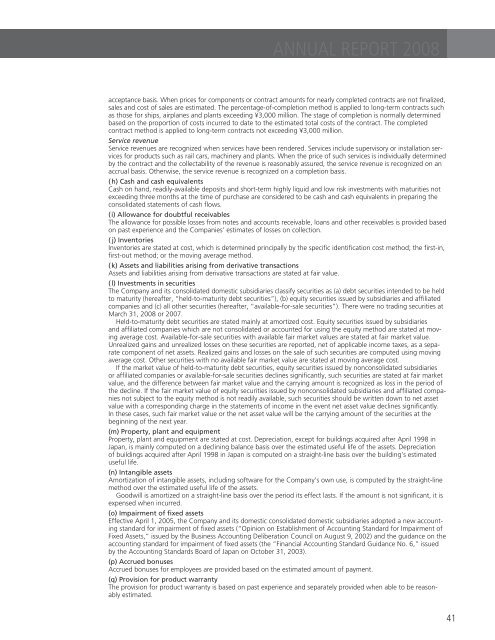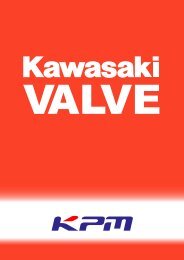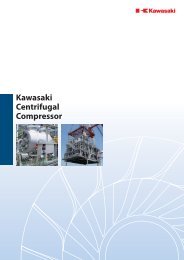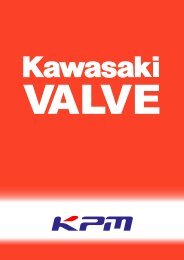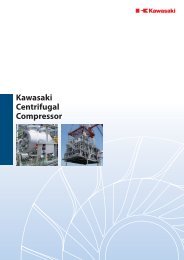Notes to the Consolidated Financial StatementsKawasaki Heavy Industries, Ltd. and Consolidated SubsidiariesKAWASAKI HEAVY INDUSTRIES, LTD.1. Basis ofPresentingConsolidatedFinancialStatementsKawasaki Heavy Industries, Ltd. (the “Company”) and its consolidated domestic subsidiaries maintain their officialaccounting and disclosure records in Japanese yen. The accompanying consolidated financial statements have beenprepared in accordance with the provisions set forth in the Japanese Financial Instruments and Exchange Lawand its related accounting regulations and in conformity with accounting principles generally accepted in Japan,which are different in certain respects as to application and disclosure requirements from International Financial<strong>Report</strong>ing Standards.The accounts of overseas subsidiaries are based on their accounting records maintained in conformity with generallyaccepted accounting principles prevailing in the respective countries of domicile. The accompanying consolidatedfinancial statements have been restructured and translated into English, with some expanded descriptionsand the inclusion of consolidated statements of changes in net assets, from the consolidated financial statementsof the Company prepared in accordance with Japanese GAAP and filed with the appropriate Local Finance Bureauof the Ministry of Finance as required by the Financial Instruments and Exchange Law. Some supplementary informationincluded in the statutory Japanese language consolidated financial statements, but not required for fairpresentation, is not presented in the accompanying consolidated financial statements.The translations of the Japanese yen amounts into U.S. dollar amounts are included solely for the convenienceof readers outside Japan, using the prevailing exchange rate at March 31, <strong>2008</strong>, which was ¥100.20 to US$1.00.The translations should not be construed as representations that the Japanese yen amounts have been, could havebeen or could in the future be converted into U.S. dollars at this or any other rate of exchange.2. SignificantAccountingPolicies(a) ConsolidationThe accompanying consolidated financial statements include the accounts of the Company and significant companies(together, the “Companies”) over which the Company has power of control through majority voting rights orthe existence of certain other conditions evidencing control.The consolidated financial statements include the accounts of the Company and 95 (96 in 2007 and 96 in 2006)subsidiaries.For the year ended March 31, <strong>2008</strong>, 3 subsidiaries (3 in 2007 and 5 in 2006) were excluded from the consolidation.The amount of total assets, net sales, net income and retained earnings of these excluded subsidiaries,in the aggregate, would not have had a material effect on the consolidated financial statements if they wereincluded in the consolidation.(b) Application of the equity method of accountingInvestments in nonconsolidated subsidiaries and affiliates over which the Company has the ability to exercisesignificant influence over operating and financial policies are accounted for by the equity method.For the year ended March 31, <strong>2008</strong>, 18 affiliates (19 in 2007 and 19 in 2006) were accounted for by the equitymethod.For the year ended March 31, <strong>2008</strong>, investments in 2 nonconsolidated subsidiaries (3 in 2007 and 5 and 2006)and 14 affiliates (13 in 2007 and 15 in 2006), were stated at cost without applying the equity method of accounting.If the equity method had been applied for these investments, net income and retained earnings of theseexcluded subsidiaries and affiliates would not have had a material effect on the consolidated financial statements.(c) Consolidated subsidiaries’ fiscal year-endThe fiscal year-end of 28 consolidated subsidiaries (29 in 2007 and 35 in 2006) is December 31.These subsidiaries are consolidated as of December 31. Unusual significant transactions for the period betweenDecember 31 and March 31, the Company’s year-end, are adjusted on consolidation.(d) Elimination of inter-company transactions and accountsAll significant inter-company transactions and accounts and unrealized inter-company profits are eliminated onconsolidation, and the portion attributable to minority interests is credited to minority interests.In the elimination of investments in subsidiaries, the assets and liabilities of the subsidiaries, including the portionattributable to minority shareholders, are evaluated using the fair value at the time the Company acquired controlof the respective subsidiary.(e) Foreign currency translationReceivables and payables denominated in foreign currencies are translated into Japanese yen at the year-end rate.The balance sheets of consolidated overseas subsidiaries are translated into Japanese yen at the year-end rate,except for shareholders’ equity accounts, which are translated at historical rates. The income statements ofconsolidated overseas subsidiaries are translated at average rates, except for transactions with the Company,which are translated at the rates used by the Company.The Company and its domestic subsidiaries report foreign currency translation adjustments in net assets.(f) Appropriations of retained earningsAppropriations of retained earnings are recorded in the fiscal year when the proposed appropriations areapproved.(g) Revenue recognitionSale of products and construction contractsSales of products such as ships, rail cars, airplanes, machinery and motorcycles are principally recognized upondelivery. Contract revenue for construction of plants, machinery, bridges etc. is principally recognized on a customer40
ANNUAL REPORT <strong>2008</strong>acceptance basis. When prices for components or contract amounts for nearly completed contracts are not finalized,sales and cost of sales are estimated. The percentage-of-completion method is applied to long-term contracts suchas those for ships, airplanes and plants exceeding ¥3,000 million. The stage of completion is normally determinedbased on the proportion of costs incurred to date to the estimated total costs of the contract. The completedcontract method is applied to long-term contracts not exceeding ¥3,000 million.Service revenueService revenues are recognized when services have been rendered. Services include supervisory or installation servicesfor products such as rail cars, machinery and plants. When the price of such services is individually determinedby the contract and the collectability of the revenue is reasonably assured, the service revenue is recognized on anaccrual basis. Otherwise, the service revenue is recognized on a completion basis.(h) Cash and cash equivalentsCash on hand, readily-available deposits and short-term highly liquid and low risk investments with maturities notexceeding three months at the time of purchase are considered to be cash and cash equivalents in preparing theconsolidated statements of cash flows.(i) Allowance for doubtful receivablesThe allowance for possible losses from notes and accounts receivable, loans and other receivables is provided basedon past experience and the Companies’ estimates of losses on collection.( j) InventoriesInventories are stated at cost, which is determined principally by the specific identification cost method; the first-in,first-out method; or the moving average method.(k) Assets and liabilities arising from derivative transactionsAssets and liabilities arising from derivative transactions are stated at fair value.(l) Investments in securitiesThe Company and its consolidated domestic subsidiaries classify securities as (a) debt securities intended to be heldto maturity (hereafter, “held-to-maturity debt securities”), (b) equity securities issued by subsidiaries and affiliatedcompanies and (c) all other securities (hereafter, “available-for-sale securities”). There were no trading securities atMarch 31, <strong>2008</strong> or 2007.Held-to-maturity debt securities are stated mainly at amortized cost. Equity securities issued by subsidiariesand affiliated companies which are not consolidated or accounted for using the equity method are stated at movingaverage cost. Available-for-sale securities with available fair market values are stated at fair market value.Unrealized gains and unrealized losses on these securities are reported, net of applicable income taxes, as a separatecomponent of net assets. Realized gains and losses on the sale of such securities are computed using movingaverage cost. Other securities with no available fair market value are stated at moving average cost.If the market value of held-to-maturity debt securities, equity securities issued by nonconsolidated subsidiariesor affiliated companies or available-for-sale securities declines significantly, such securities are stated at fair marketvalue, and the difference between fair market value and the carrying amount is recognized as loss in the period ofthe decline. If the fair market value of equity securities issued by nonconsolidated subsidiaries and affiliated companiesnot subject to the equity method is not readily available, such securities should be written down to net assetvalue with a corresponding charge in the statements of income in the event net asset value declines significantly.In these cases, such fair market value or the net asset value will be the carrying amount of the securities at thebeginning of the next year.(m) Property, plant and equipmentProperty, plant and equipment are stated at cost. Depreciation, except for buildings acquired after April 1998 inJapan, is mainly computed on a declining balance basis over the estimated useful life of the assets. Depreciationof buildings acquired after April 1998 in Japan is computed on a straight-line basis over the building’s estimateduseful life.(n) Intangible assetsAmortization of intangible assets, including software for the Company’s own use, is computed by the straight-linemethod over the estimated useful life of the assets.Goodwill is amortized on a straight-line basis over the period its effect lasts. If the amount is not significant, it isexpensed when incurred.(o) Impairment of fixed assetsEffective April 1, 2005, the Company and its domestic consolidated domestic subsidiaries adopted a new accountingstandard for impairment of fixed assets (“Opinion on Establishment of Accounting Standard for Impairment ofFixed Assets,” issued by the Business Accounting Deliberation Council on August 9, 2002) and the guidance on theaccounting standard for impairment of fixed assets (the “Financial Accounting Standard Guidance No. 6,” issuedby the Accounting Standards Board of Japan on October 31, 2003).(p) Accrued bonusesAccrued bonuses for employees are provided based on the estimated amount of payment.(q) Provision for product warrantyThe provision for product warranty is based on past experience and separately provided when able to be reasonablyestimated.41
- Page 1 and 2: Annual Report 2008Year ended March
- Page 3: Consolidated Financial HighlightsKa
- Page 6 and 7: KAWASAKI HEAVY INDUSTRIES, LTD.Thus
- Page 8 and 9: An Interview with Tadaharu Ohashi,
- Page 10 and 11: KAWASAKI HEAVY INDUSTRIES, LTD.Q:Wh
- Page 12 and 13: AbcdeKawasaki Heavy Industries, Ltd
- Page 14 and 15: Review of OperationsKAWASAKI HEAVY
- Page 16 and 17: Review of OperationsKAWASAKI HEAVY
- Page 18 and 19: Review of OperationsKAWASAKI HEAVY
- Page 20 and 21: Review of OperationsKAWASAKI HEAVY
- Page 22 and 23: Review of OperationsKAWASAKI HEAVY
- Page 24 and 25: Review of OperationsKAWASAKI HEAVY
- Page 26 and 27: Review of OperationsKAWASAKI HEAVY
- Page 28 and 29: Six-Year Abcde SummaryKawasaki Heav
- Page 30 and 31: KAWASAKI HEAVY INDUSTRIES, LTD.annu
- Page 32 and 33: KAWASAKI HEAVY INDUSTRIES, LTD.Euro
- Page 34 and 35: KAWASAKI HEAVY INDUSTRIES, LTD.Plan
- Page 36 and 37: Consolidated Balance SheetsKawasaki
- Page 38 and 39: Consolidated Statements of IncomeKa
- Page 40 and 41: Consolidated Statements of Cash Flo
- Page 44 and 45: KAWASAKI HEAVY INDUSTRIES, LTD.(r)
- Page 46 and 47: KAWASAKI HEAVY INDUSTRIES, LTD.(d)
- Page 48 and 49: KAWASAKI HEAVY INDUSTRIES, LTD.Basi
- Page 50 and 51: KAWASAKI HEAVY INDUSTRIES, LTD.(c)
- Page 52 and 53: KAWASAKI HEAVY INDUSTRIES, LTD.(a)
- Page 54 and 55: KAWASAKI HEAVY INDUSTRIES, LTD.The
- Page 56: KAWASAKI HEAVY INDUSTRIES, LTD.(d)
- Page 59 and 60: ANNUAL REPORT 2008EXECUTIVE OFFICER
- Page 61 and 62: ANNUAL REPORT 2008Paid-in CapitalEq
- Page 63 and 64: NetworkANNUAL REPORT 2008Kobe Head
- Page 65 and 66: Corporate DataANNUAL REPORT 2008Kaw


